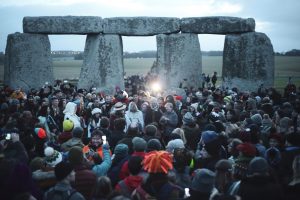Every year, between December 20th and 23rd, a winter solstice occurs in the Northern Hemisphere and results in not only the shortest day and longest night of the year, but also the start of Winter! Dating back to the Neolithic period, the winter solstice is seen by many around the world as a time to celebrate culture, religion, and astronomy!
So, how does this winter solstice occur? Because our Earth is tilted on its axis while it spins, the Northern and Southern hemispheres receive unequal amounts of sunlight. As a result, we experience seasons and solstices! When the northern hemisphere is at its maximum tilt, the hemisphere will then have an unusually short period of daylight and the longest period of nighttime. This extreme tilt lasts only a minute to us, but as a result of the solstice, each day will progressively get longer by the minute. This goes on until June in which the summer solstice occurs!
Around the world, the winter solstice is celebrated through traditions or feasts, as well as the gathering of communities and families. As explained, this scientific experience dates back to the Neolithic period and proof of that lies in the prehistoric monument, “Stonehenge,” which dates back to 2500 BC. Many have theorized the importance and reason for the Stonehenge’s existence, but evidence shows how the stones were set up in order to know when this solstice occurs to mark the end of the farming season. English Heritage explains that the stones are set up for the sun to shine directly through them on two days, the winter solstice and the summer solstice.

In Iran, Yalda is a Persian festival to celebrate the sun. The celebration lasts all night on the night of the solstice, so some families stay up eating food together to experience the sunrise. This celebration is considered a birthday for the sun and a victory of light over darkness. In China, this tradition is referred to as Dong Zhi, or the “arrival of winter.” Families will gather on this night to have great meals together while hoping for a warm spring in the future.

In Ancient Rome, Saturnalia was a time to honor the planet Saturn, which is connected with the Roman god of agriculture, and rebuild connections within the community. Most businesses and schools were closed, and wars were paused, but this resulted in crime rising because nobody was enforcing the law on this day. Eventually, the tradition overall faded, but many still celebrate it today.
The winter solstice is one of the few things everybody on earth has in common, so it is sure to be something to be observed and enjoyed. Marking the end of the warm weather and fun in the sun, the winter solstice brings in winter chill and long-drawn-out days. Get your coats and hot chocolate ready to welcome the winter solstice!
Written By: Kathryn Cottingham
November 24, 2021
